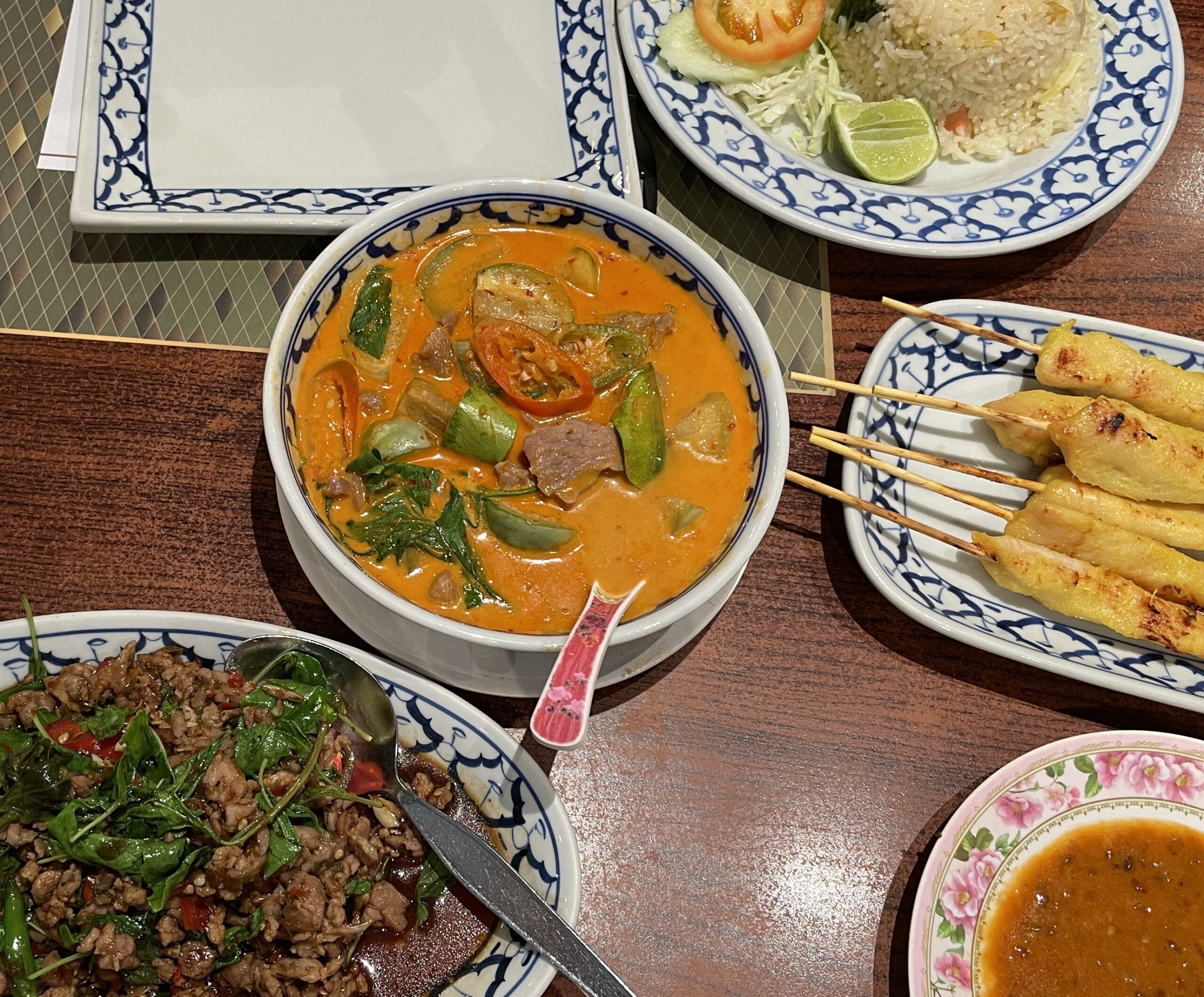13 Must Try Thai Dishes for First-Time Visitors
I still remember the first time I landed in Bangkok; it was late at night, and as my Grab taxi took me toward my hotel, I passed rows of glowing night markets.
Locals and travelers crowded around tiny plastic tables, devouring bowls of noodles and skewers hot off the grill. That was my first authentic taste of the magic of must try Thai dishes, seeing the city alive with flavor.
My actual first bite, though, came hours later at 3 AM. Jet‑lagged and hungry, I ordered a random meal on Grab: charcoal‑grilled beef with fiery chili peppers on the side, plus the beloved Thai sticky rice. Maybe it was just the late‑night hunger talking, but it was incredible. Years later, and after many trips to Thailand, I still think about that simple meal.
Since that first night, I’ve spent months traveling across Thailand, from the street stalls of Bangkok to the markets of Chiang Mai and the beachside grills of Krabi.
I’ve eaten my way through every region, from iconic dishes to quirky local bites (yes, even the occasional fried insects).
This guide is my list of 13 Thai dishes you must try during your first‑time. These are the flavors that define Thailand: spicy, sweet, sour, and savory in perfect balance, and the meals that will stay with you long after your trip!
1. Khao Soi
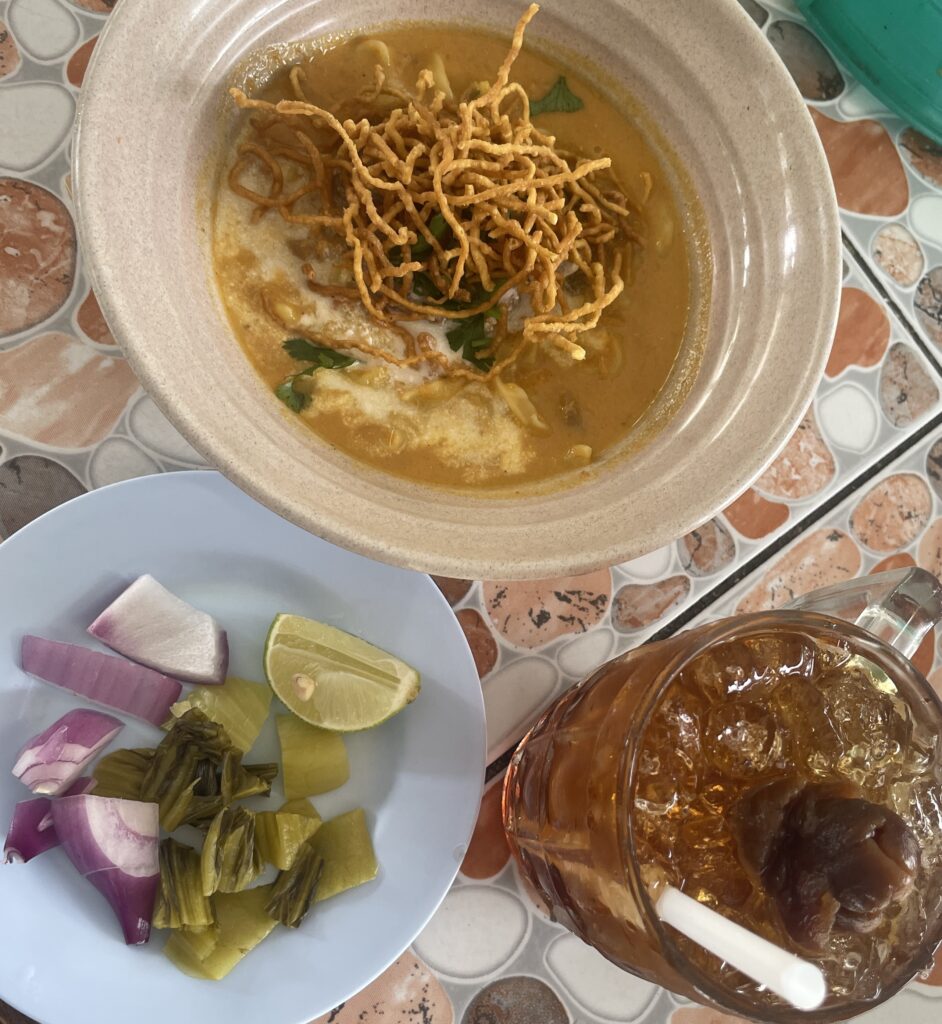
I didn’t try Khao Soi my first time in Thailand, and looking back, I regret waiting. I knew I’d be heading north later that year, and I wanted my first bowl to be in Chiang Mai, where this dish was born.
When I finally sat down at a small family‑run shop with the smell of curry and fried shallots in the air, I realized why this is one of Thailand’s must‑try dishes.
Khao Soi is a creamy, coconut‑based curry noodle soup topped with crispy fried noodles, served with sides like pickled mustard greens, raw onion, and a wedge of lime to balance the richness.
Traditionally, it’s made with chicken, but beef, pork, and even vegetarian versions are easy to find.
What makes it unforgettable is the flavor layering, the first spoonful is creamy and slightly sweet, then the chili oil kicks in, and the pickled greens add that perfect tang. It’s comforting yet vibrant, and the crispy noodles give it that satisfying crunch every bite needs.
Over the years, I’ve eaten my way through some of the best Khao Soi spots in Chiang Mai, from hidden street stalls to trendy cafes. Each bowl has its personality, some richer and creamier, others packing a heavier chili punch.
If you’re visiting Thailand, make Khao Soi one of the first dishes you try. It’s a signature taste of the country, and once you have that first spoonful, you’ll understand!
2. Som Tum (Papaya Salad)
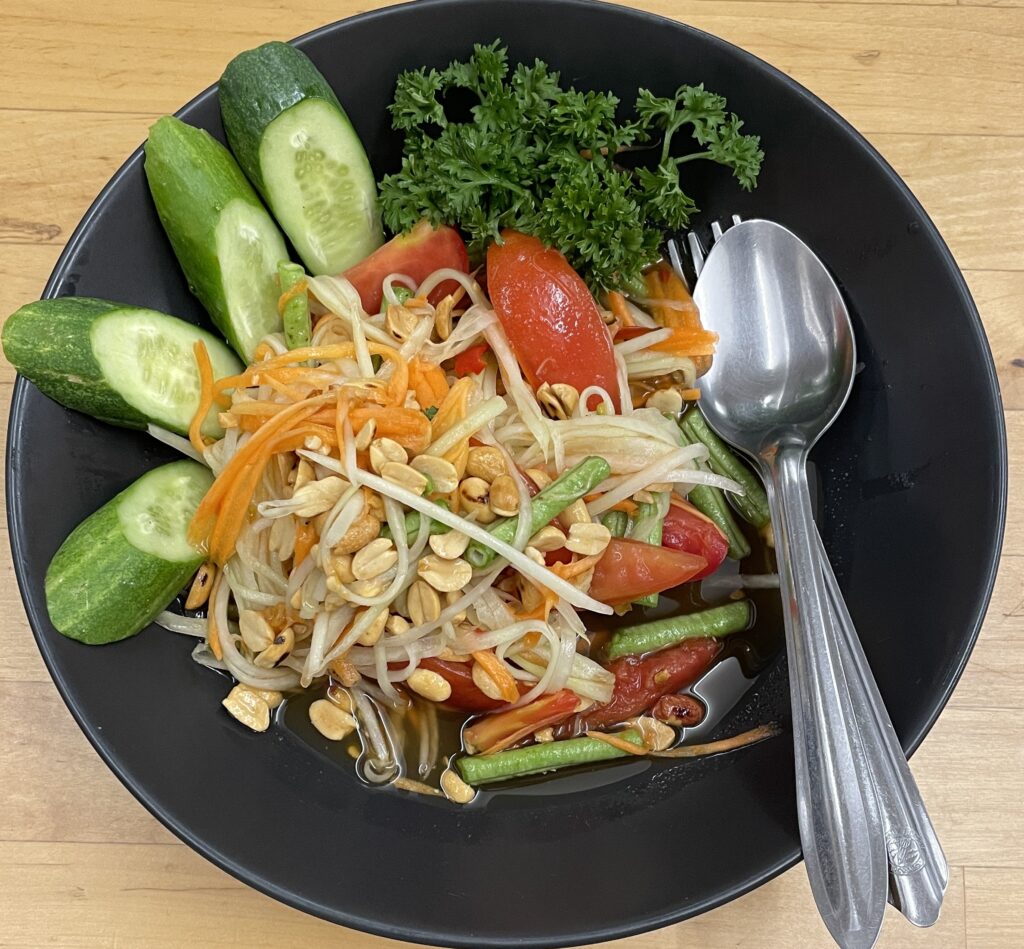
When I first visited Thailand and kept hearing that papaya salad, locally called Som Tum, was a must‑try dish, I was honestly a bit confused. Out of all the incredible foods in Thailand, a salad makes the must‑eat list?
Then I tried it, and I instantly understood the hype. Som Tum is a flavor explosion in every bite, and you must try it when in Thailand for your first visit.
The shredded green papaya is crisp and refreshing, the crushed peanuts add a perfect crunch, and the dressing hits all the notes, spicy, tangy, salty, and just a touch sweet. Traditionally, it’s pounded together with lime juice, fish sauce, garlic, chili, and palm sugar, which makes each bite a mix of fiery heat and bright acidity.
If you’re new to Thai food, just a small warning: authentic Som Tum is usually served quite spicy. Luckily, you can ask the vendor to tone it down if you need to, but a little heat is what really makes the flavors sing.
3. Pad Kra Pao
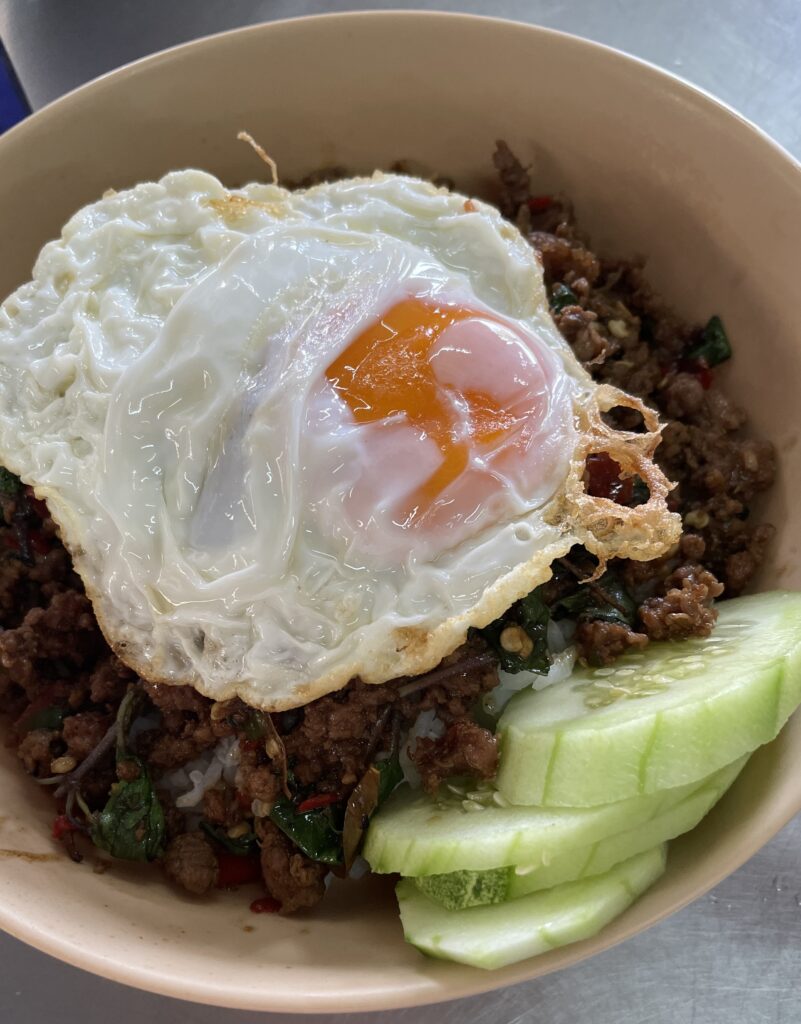
If there’s one Thai dish I could eat every single day, it would be Pad Kra Pao. On the surface, it looks simple: minced pork stir‑fried with Thai holy basil, served over rice with a fried egg on top.
But one bite and you realize why this is one of the most beloved everyday meals in Thailand.
I always ask for the egg right on top of the rice; that golden yolk breaking over the spicy, garlicky basil stir‑fry just takes the whole dish to the next level.
Despite how quick it is to make (a good street‑food chef will have it ready in minutes), it packs huge flavor: salty, spicy, a hint of sweetness, and that unmistakable aroma of fresh basil.
While pork is the most common choice, you’ll often find beef Pad Kra Pao as well, and occasionally minced chicken. No matter the protein, this dish is Thai comfort food at its best, humble, flavorful, and endlessly satisfying.
4. Massaman Curry
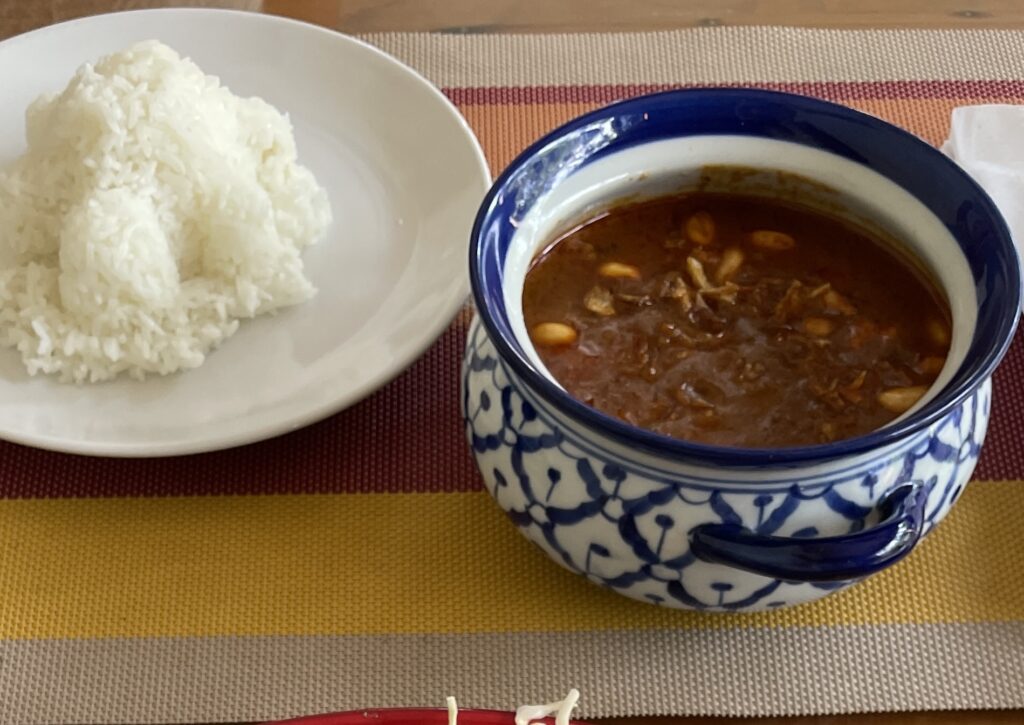
Massaman Curry is unlike any other Thai curry, it’s rich, fragrant, and a little bit sweet, with a flavor profile that reflects its Southern Thai roots and Muslim influences.
This is a dish where Thailand meets the spice trade, with cinnamon, cardamom, cloves, and nutmeg adding a warming depth you won’t find in typical green or red curries.
The curry is usually slow‑cooked with beef, lamb, or chicken, potatoes, and roasted peanuts, all soaking in a creamy coconut milk base.
What makes Massaman special to me is its balance: the spices are bold, yet not fiery, and the sweetness from coconut milk and palm sugar makes it incredibly comforting.
I’ve had some of my favorite Massaman curries in Krabi and Phuket, where the southern influence is strongest, but you can find it across Thailand.
It’s the kind of dish that will win over anyone nervous about Thai heat; it’s flavorful without being overwhelmingly spicy, making it perfect for first‑time visitors easing into Thai cuisine.
5. Tom Yum Soup (Collectively)
If there’s one soup that screams “Thailand,” it’s Tom Yum. Originating in Central Thailand, this hot and sour soup is the country in a bowl, fragrant lemongrass, kaffir lime leaves, galangal, and chilies combine to create a punchy, aromatic broth.
The original and most classic version is Tom Yum Goong, made with fresh river shrimp. That first sip is unforgettable: tangy from lime, quite spicy from chili, and bursting with herbal freshness.
Over the years, I’ve tried all the variations:
- Tom Yum Nam Sai – a clear, lighter version where the flavors shine bright and sharp.
- Tom Yum Nam Khon – the creamy version with evaporated milk or coconut milk that gives a rich, slightly silky texture.
- Seafood or chicken variations – popular across the country, especially near the coasts, where fresh catch is abundant.
Whenever I land in Bangkok, Tom Yum is often one of the first things I order. Whether I’m in a riverside restaurant or at a simple street stall, it never fails to wake up my taste buds and remind me I’m in Thailand.
6. Thai Grilled Chicken (Kai Yang)
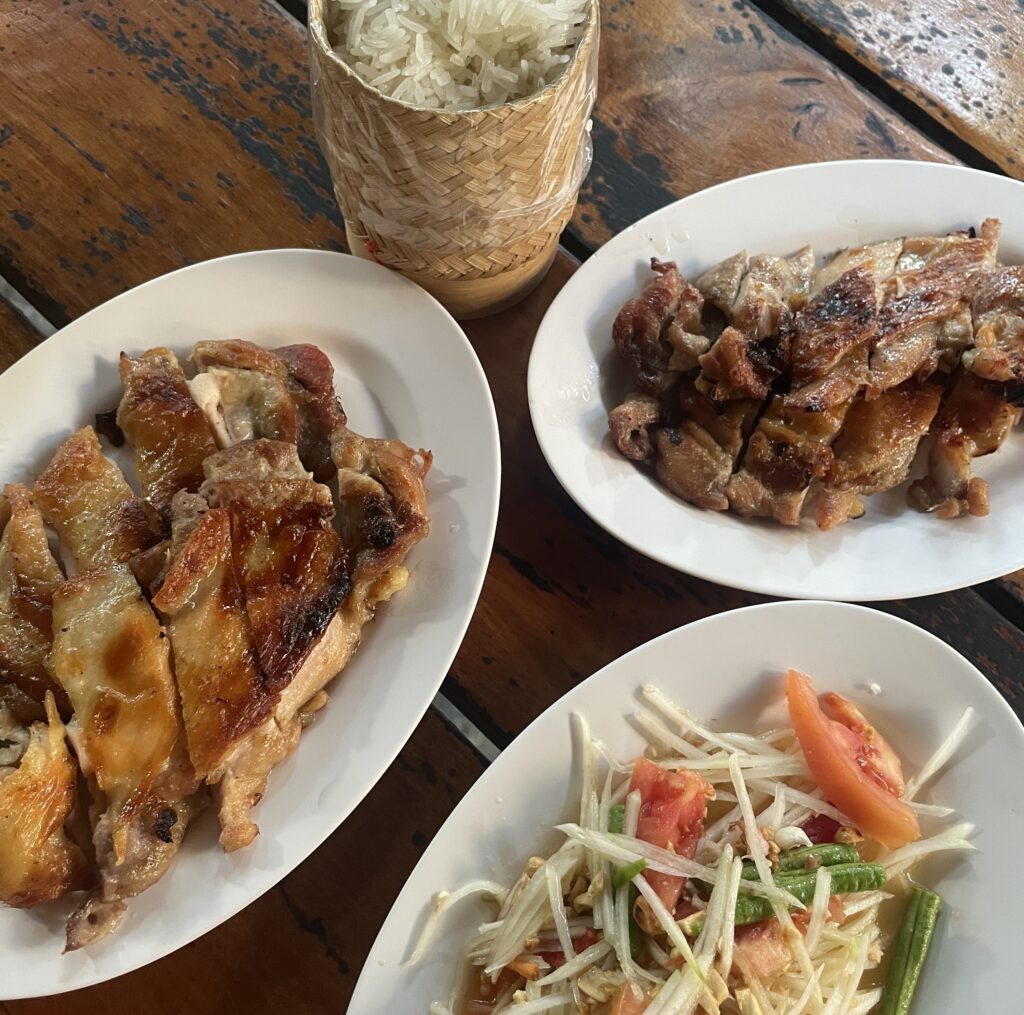
I bet you weren’t expecting grilled chicken to make a list of must‑try Thai dishes, but hear me out. Even TasteAtlas ranks Kai Yang among the country’s top foods, and they know their stuff.
Kai Yang is my ultimate comfort meal in Thailand. Juicy, perfectly seasoned chicken is grilled low and slow over charcoal, giving it that smoky aroma that hits you before the first bite. The skin crisps up beautifully while the meat stays tender and flavorful.
The dish is usually paired with sticky rice and a side of Som Tum (papaya salad); the combination of smoky chicken, tangy‑spicy salad, and soft, warm rice is the perfect Thai trio.
You’ll spot these chicken stalls everywhere, from street vendors in Isaan, where the dish originates, to busy Bangkok night markets, and even upscale Thai restaurants.
If you’re walking past a stall and catch that charcoal fragrance, do yourself a favor: stop, order, and dig in. It’s simple, it’s rustic, and it’s unforgettable.
7. Pad Thai
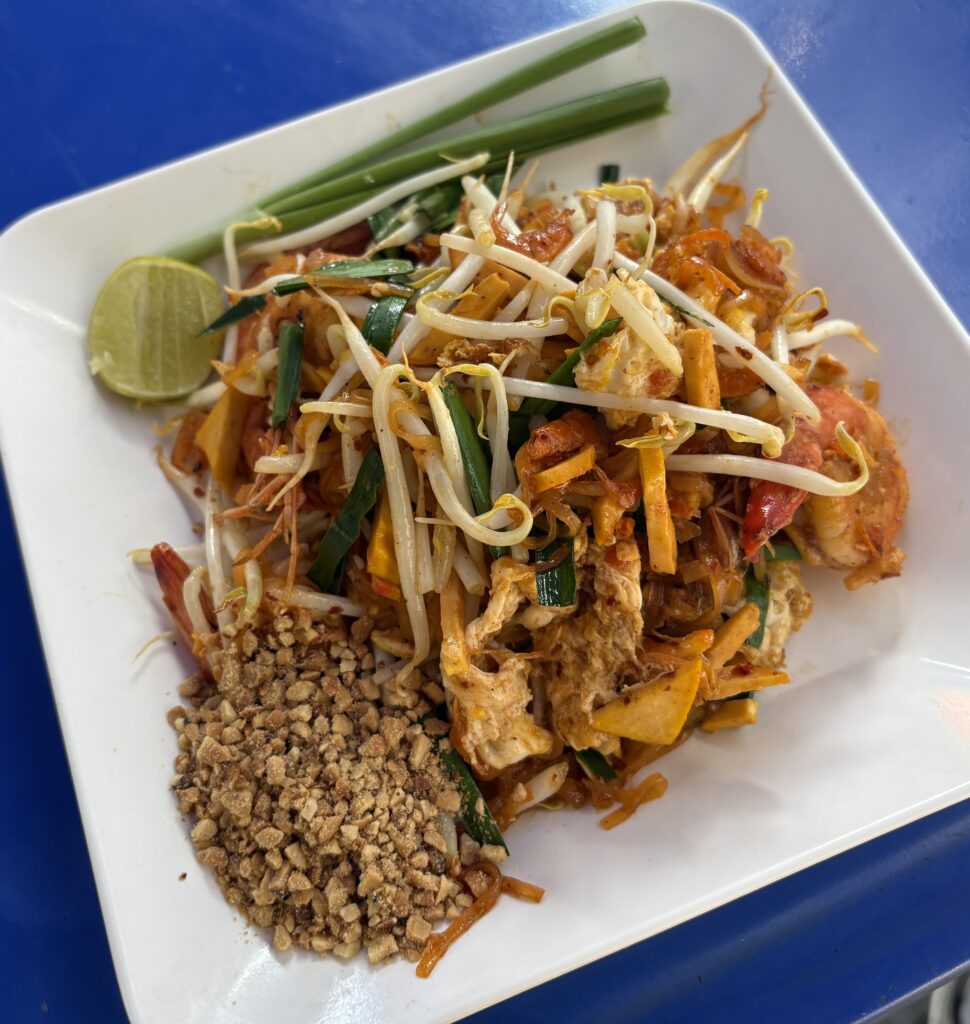
It’s impossible to make a list of must‑try Thai dishes without including Pad Thai. Honestly, it’s one of my all‑time favorites.
Growing up in Canada, Pad Thai was my very first exposure to Thai cuisine. It’s probably the same for many of you, this dish is one of Thailand’s most internationally recognized foods.
Part of its global popularity comes from its approachability. Traditional Thai flavors can be bold and spicy, but Pad Thai is mild, balanced, and packed with that addictive sweet‑savory tang.
In Thailand, though, it tastes on a whole different level. The noodles are wok‑fried to perfection, picking up that subtle smoky “wok hei” char, and the fresh ingredients make it sing in a way you just can’t replicate abroad.
While you’ll find versions with chicken, tofu, or seafood, the classic street‑style Pad Thai usually comes with prawns and a light coating of egg, tossed with bean sprouts, scallions, and a squeeze of lime. A sprinkle of crushed peanuts and optional chili flakes on the side lets you adjust the flavor to your liking.
8. Panang Curry
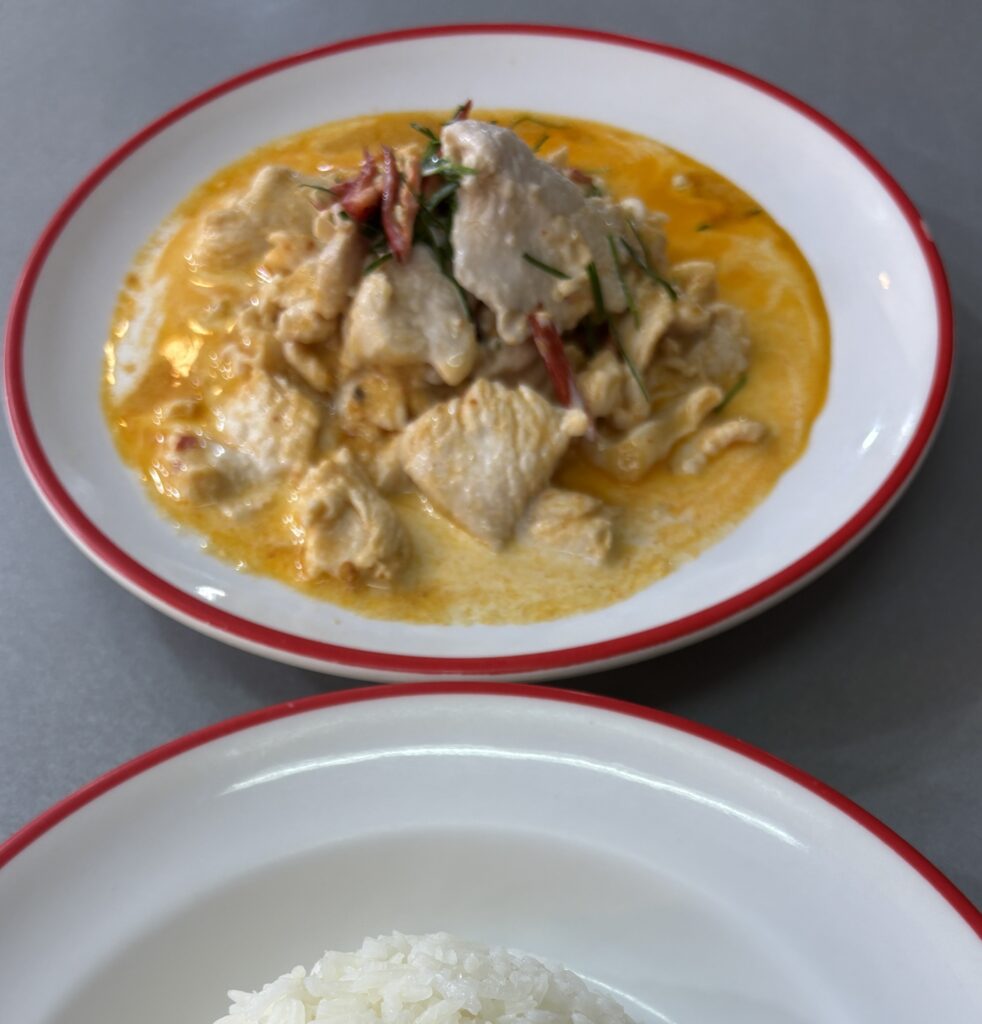
If you’re into Thai curries, Panang Curry will win you over fast. It’s technically a type of red curry, but it’s thicker, creamier, and slightly sweeter than the standard version.
The first time I had Panang Curry in Southern Thailand, I instantly understood why so many travelers rave about it; it’s the kind of dish where the sauce is so good you’ll find yourself scraping the bowl clean with rice.
Panang typically comes with tender slices of beef or chicken, though you’ll see seafood and even vegetarian versions in more touristy areas. What makes it special is the balance of creamy coconut milk, red curry paste, crushed peanuts, and kaffir lime leaves.
That lime leaf aroma hits you first, and then the rich, nutty flavor follows. It’s comforting but still has that Thai punch of flavor.
If you’re only trying one curry in Thailand, this is the one that will probably steal your heart, especially if you’re traveling through the South, where creamy, coconut‑heavy curries are the local specialty.
9. Thai Meat Skewers (Collectively)
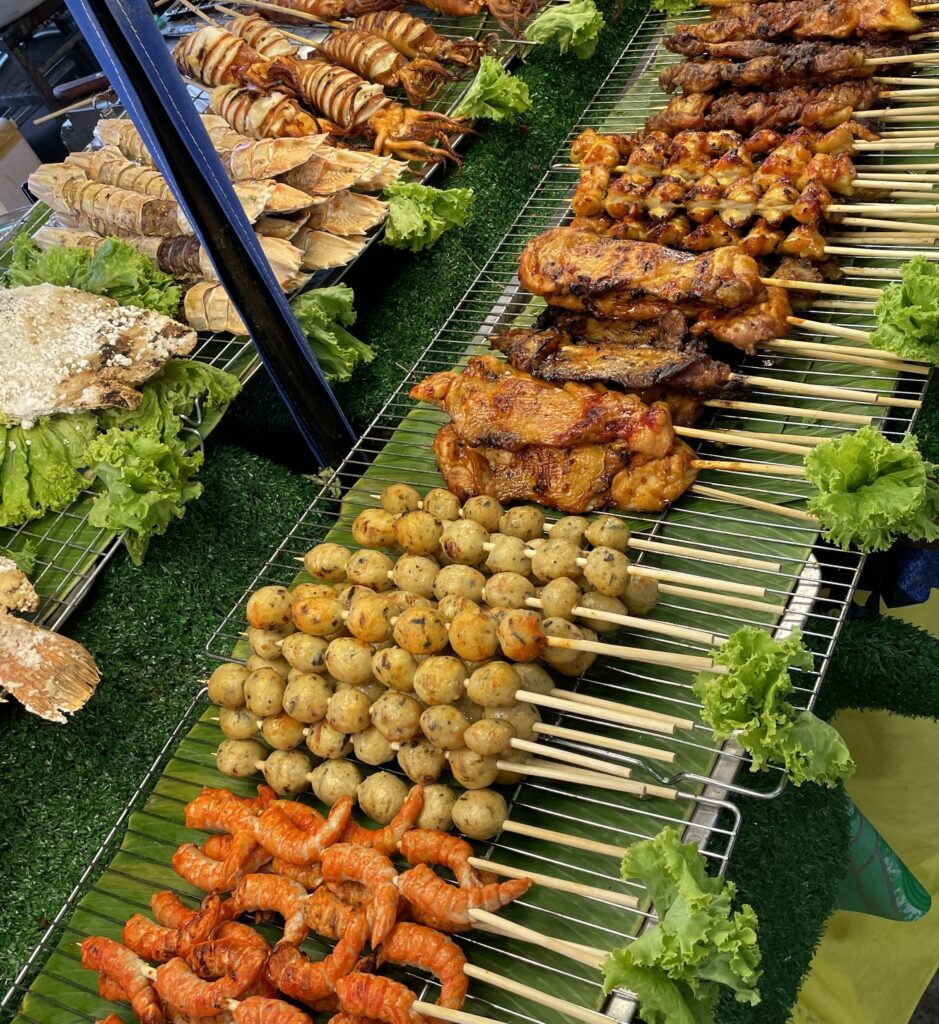
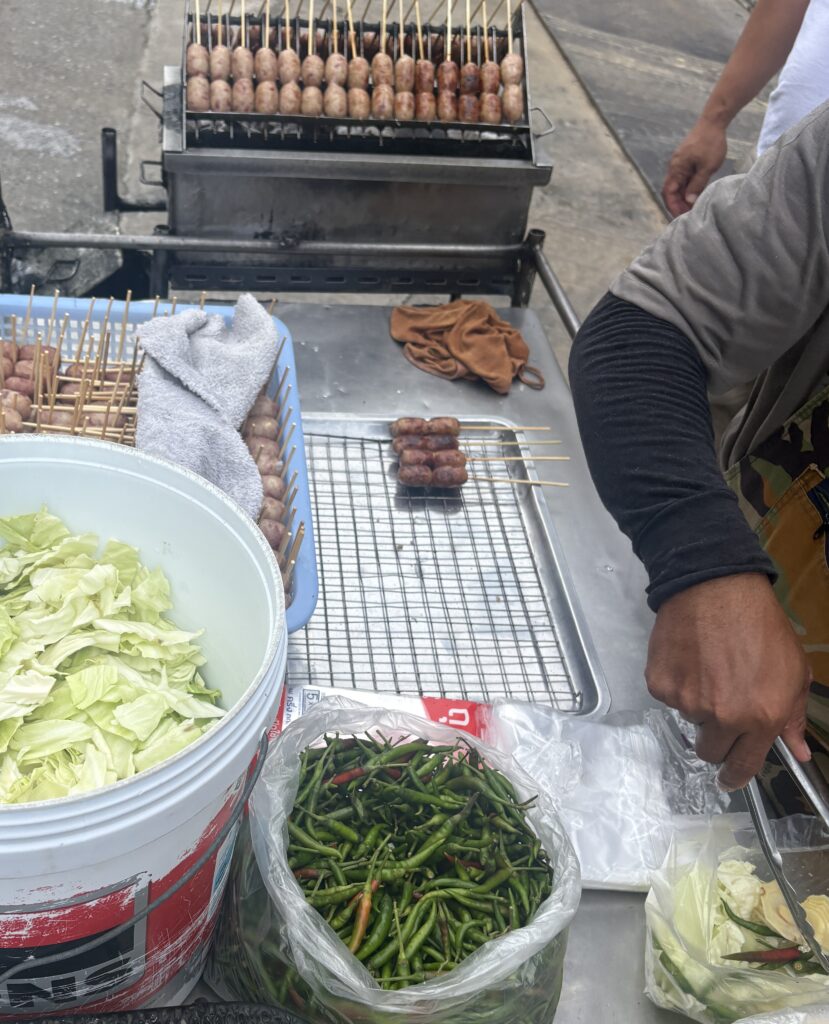
You can’t walk more than a few steps in a Thai night market without catching the smell of grilled meat skewers sizzling away. These skewers are one of my go‑to street foods in Thailand, cheap, satisfying, and perfect as a quick snack while you wander.
Most vendors now use electric grills, which still cook the skewers perfectly, but every now and then, you’ll spot a vendor with a charcoal grill. Trust me, if you see charcoal, go for it, that smoky flavor takes the meat to another level.
Here are the most popular skewers you’ll come across:
- Moo Ping – marinated grilled pork, juicy and slightly sweet.
- Gai Ping – tender grilled chicken skewers with a light garlic‑soy taste.
- Beef skewers – sometimes spicy, always flavorful.
- Chicken Satay – marinated in turmeric and spices, served with that addictive peanut sauce.
- Squid skewers – smoky and a little chewy, perfect with a squeeze of lime.
- Fish balls on a stick – bouncy and mild, usually served with sweet chili sauce.
TIP: Grab two or three skewers fresh off the grill, pair them with a little bag of sticky rice, and stroll the market like a local. It’s one of those simple Thai street meals that will instantly hook you!
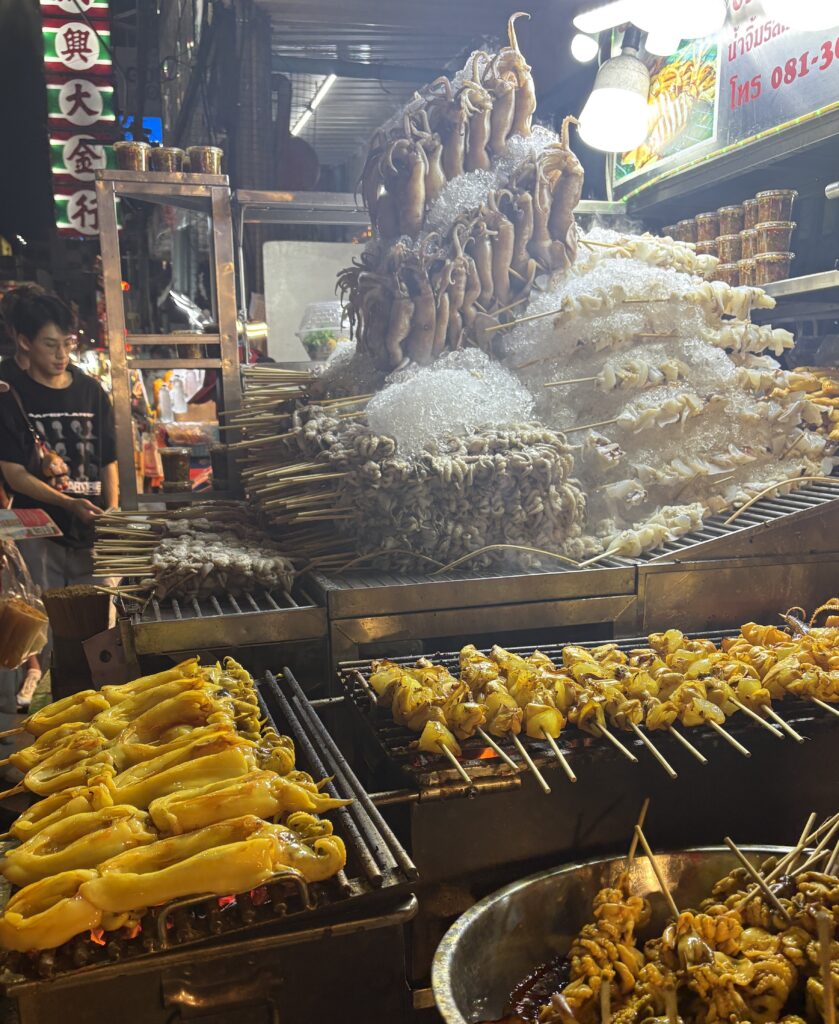
10. Tom Kha Gai
If Tom Yum Soup is the bold, fiery sibling, Tom Kha Gai is the comforting, creamy cousin. This soup is made with coconut milk, galangal, lemongrass, kaffir lime leaves, and tender pieces of chicken, creating a rich broth that’s both fragrant and soothing.
The first time I tried it, I wasn’t prepared for how much I’d love it. The coconut milk softens the spice and brings a gentle sweetness, while the galangal and lemongrass add a bright, citrusy lift.
It’s the kind of soup that makes you slow down, breathe in the aroma, and appreciate just how layered Thai flavors can be.
While you’ll find Tom Kha Gai everywhere, it’s especially popular in Central Thailand around Bangkok, where coconut milk is a staple in local cooking.
I like to have it with steamed jasmine rice, letting the broth soak in; it’s the perfect balance of cozy and exotic.
11. Mango Sticky Rice
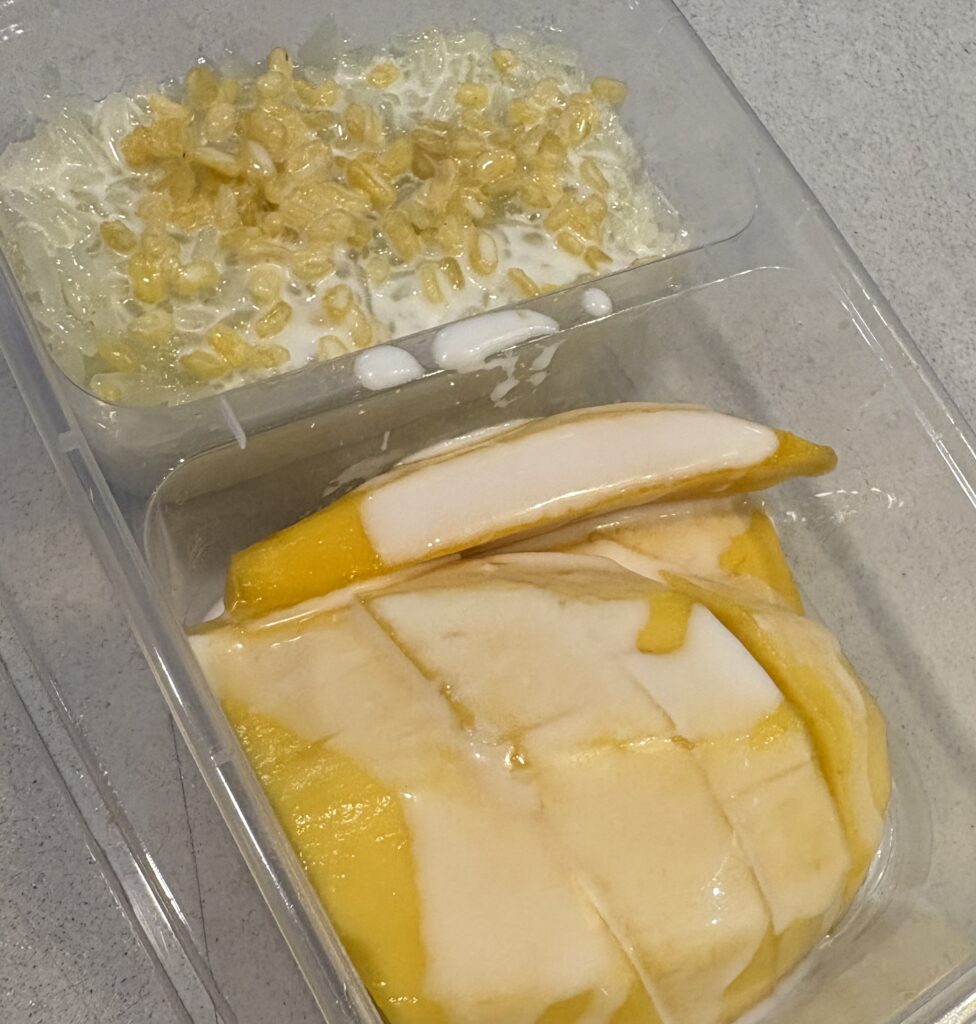
Mango sticky rice is a dessert that will always stick with me, and I’ll tell you why. Of all the countries I’ve visited and the desserts I’ve tried, this one truly surprised me.
Before my first trip to Thailand, I kept seeing mango sticky rice listed as a must‑try Thai food, and honestly, I didn’t get it.
Rice as a dessert? Coming from Canada, that sounded absurd. Sure, I knew some Asian cultures had sweet rice desserts, but this just looked like plain sticky rice with mango, nothing fancy.
Obviously, being the foodie I am, I had to try it. One night in Bangkok, I spotted a street stall where a woman was carefully preparing it. She placed the warm sticky rice, topped it with creamy, slightly sweet coconut milk, and served it alongside fresh, perfectly ripe mango slices.
One bite and I was hooked. Somehow, the sweet, creamy coconut rice, the fresh mango, and the slight saltiness of the sauce all blend into pure magic.
Every time I eat it now, it takes me back to that first late‑night taste in Bangkok. It’s a dessert that sounds simple, but once you try it, you’ll get why it’s on every “must‑eat in Thailand” list.
12. Thai Roti with Banana

For me, this is like the Thai version of a doughnut. I know what you’re thinking, “It looks nothing like a doughnut!”, but hear me out. I mean it in the sense that it’s fried, indulgent, and the perfect sweet street‑food treat to finish off a night of eating in Thailand.
You’ll find Thai roti with banana almost everywhere in Thailand, especially around tourist areas and night markets. A thin roti is fried on a hot griddle, filled with sliced banana, folded up, and topped with your choice of toppings.
My go‑to is Nutella with a drizzle of condensed milk; it’s hot, sweet, gooey, and ridiculously good. The heat from the roti melts the banana and chocolate into the perfect dessert bite.
There are many variations to try, from simple sugar and condensed milk to peanut butter, chocolate, or even savory cheese versions.
Thai-style roti, including the banana version filled with condensed milk or chocolate, was introduced by Indian Muslims and is widely sold by Thai Muslim street vendors, especially popular in urban and tourist areas.
It’s a dish that reflects cultural blending before becoming a beloved staple of Thailand’s street‑food scene.
13. 7‑Eleven Toasties (Collectively)
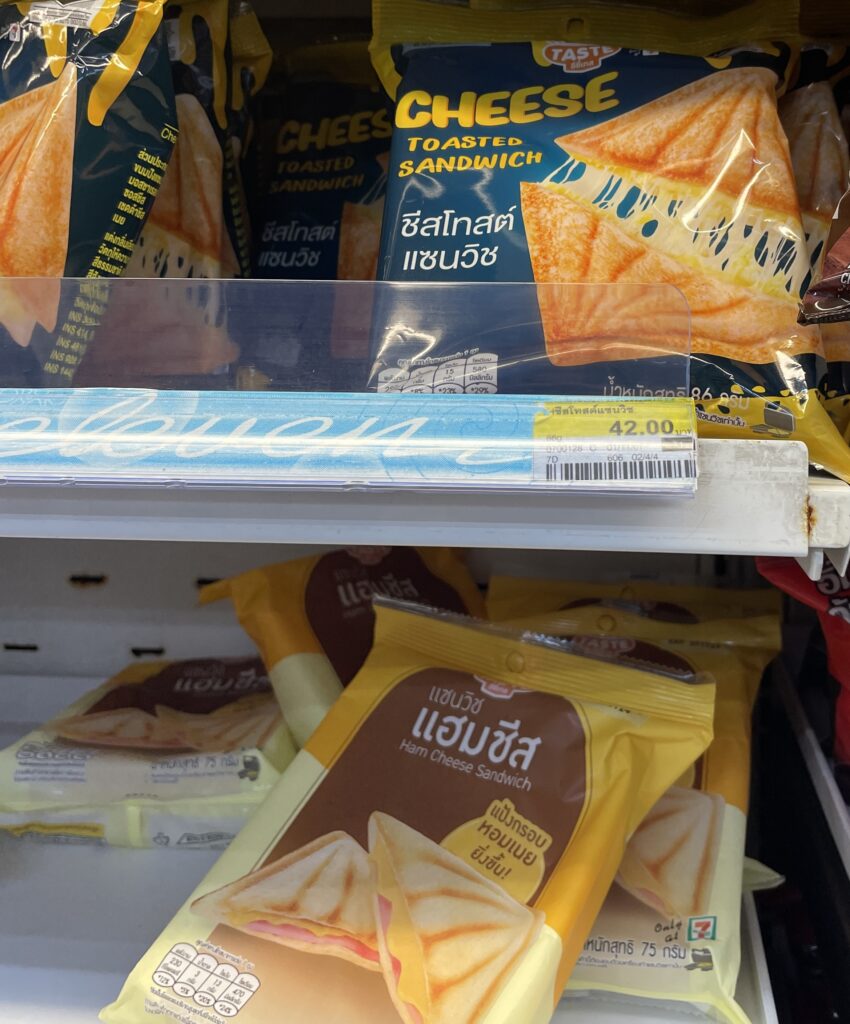
Right off the bat, I know including 7‑Eleven toasties in a list of must‑try Thai dishes is going to stir up some controversy.
Let’s be honest: at the end of the day, it’s a processed cheese sandwich heated in a press at 7‑Eleven. There’s no Michelin‑star culinary technique here. But that’s not the point.
The point is that both tourists and locals love it, and it has basically become a rite of passage for first‑time visitors to Thailand.
Walk around any city late at night and you’ll see locals grabbing toasties alongside jet‑lagged travelers.
Here’s why it went viral on social media: 7‑Elevens in Thailand are open 24/7, and their refrigerators are stacked with anywhere from 7 to 20 different toasty flavors, from ham and cheese to croissant versions and, of course, the beloved original.
You grab one, pay at the cashier, and they’ll heat it up for you in minutes. Suddenly, you’re holding hot, gooey, cheesy goodness that hits the spot after a long night out or a late‑night tuk‑tuk ride.
Over the last few years, toasties have become Instagram and TikTok legends, and honestly, they live up to the hype for what they are: cheap, satisfying, and oddly addictive.
Sure, it’s not gourmet Thai cuisine, but it’s part of the modern Thai travel experience, and that alone earns it a spot on this list.
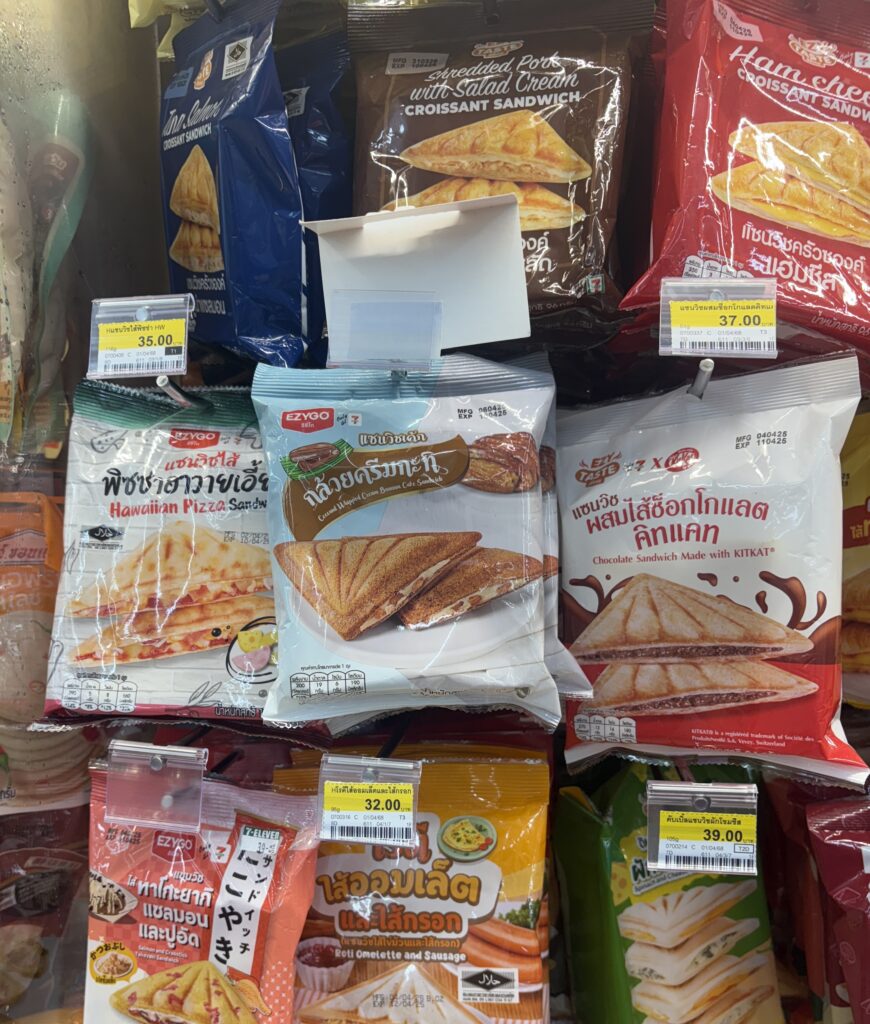
Thai Food for First‑Time Travelers: What to Know
If you’re visiting Thailand for the first time, eating your way through the country is half the adventure.
Thai food is vibrant, layered with flavor, and surprisingly approachable, but there are a few things first-time travelers should know.
Avoid these common Thailand tourist mistakes to ensure that food and dining don’t become one of them.
- Spice levels are real. Even a “little spicy” can light up your taste buds. Start mild and work your way up if you’re unsure.
- Street food is generally safe. I’ve traveled all over Thailand for years and maybe had a stomach issue once, nothing out of the ordinary for a foodie traveler. Stick to busy stalls and eat food that’s served hot.
- Mind the peanuts and common allergens. Peanuts, fish sauce, and shrimp paste pop up in plenty of Thai dishes. If you have allergies, ask first.
- Vegetarian and halal options exist. Ask for “no fish sauce” if needed, and in the south, Muslim vendors make amazing halal eats.
- Freshness is everything. Fruit shakes, grilled meats, and fried snacks taste best straight off the grill or wok—bonus points if you spot a vendor using charcoal.
Exploring Thai food with a bit of curiosity will make your trip even more memorable. If you need itinerary inspiration while you’re planning your foodie adventure, my Thailand itinerary is a great place to start.
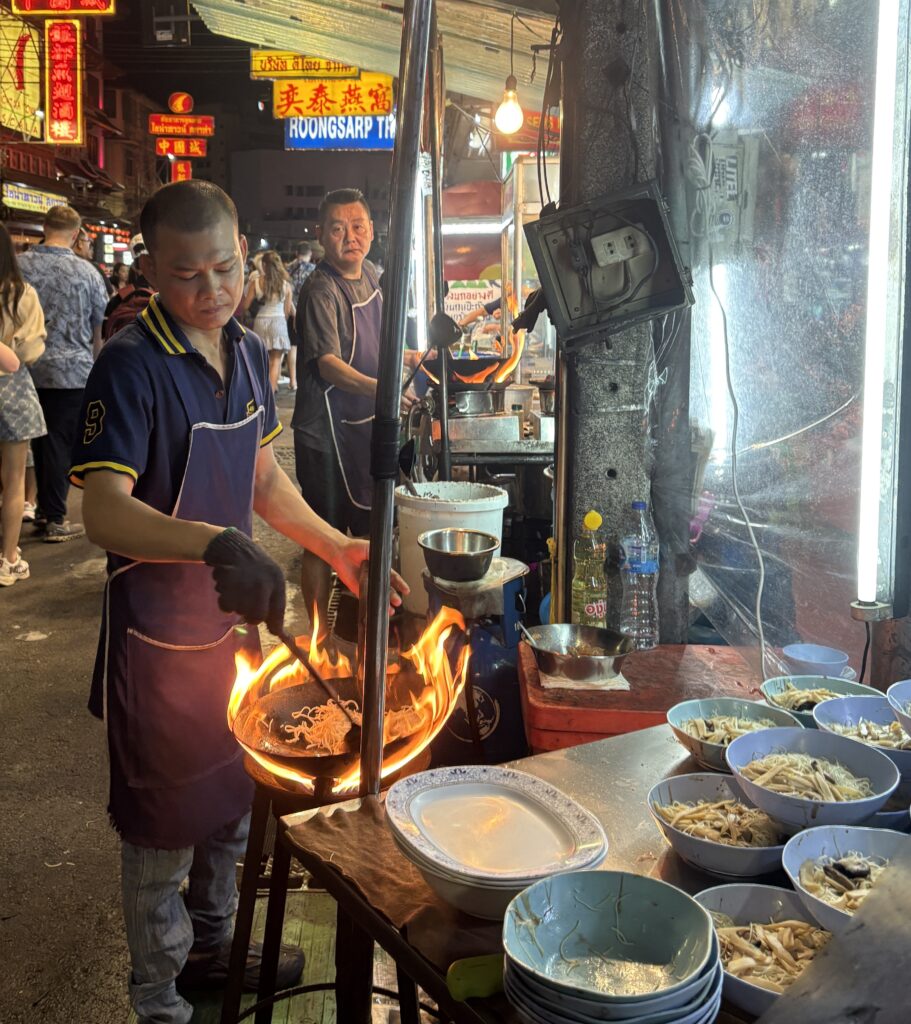
Final Thoughts: Thai Cuisine for First‑Time Visitors
It’s not just the flavors that make Thailand unforgettable; it’s the entire food culture. Food here is truly everywhere.
From tiny roadside vendors to bustling night markets, from sit‑down restaurants to Michelin‑recognized spots, and even 7‑Eleven toasties at 2 AM, you’re never far from your next bite. And the night markets? I’ve traveled to many countries, and nothing compares to Thailand’s night markets!
Walking through them is an experience in itself: the sizzling woks, the smell of grilled meats, the rainbow of curries and sweets, and locals and travelers alike snacking under neon lights.
Heading south? Don’t miss 4 days in Krabi for beaches and fresh seafood, and if your journey begins in the capital, following a Bangkok itinerary will help you navigate its endless street food and night markets.
And when it comes to the islands, knowing what it costs to enjoy Phuket ensures your foodie adventure stays stress‑free from start to finish.
Thailand rewards the hungry and the curious. Come with an open mind and an empty stomach, you’ll leave with some of the best food memories of your life!
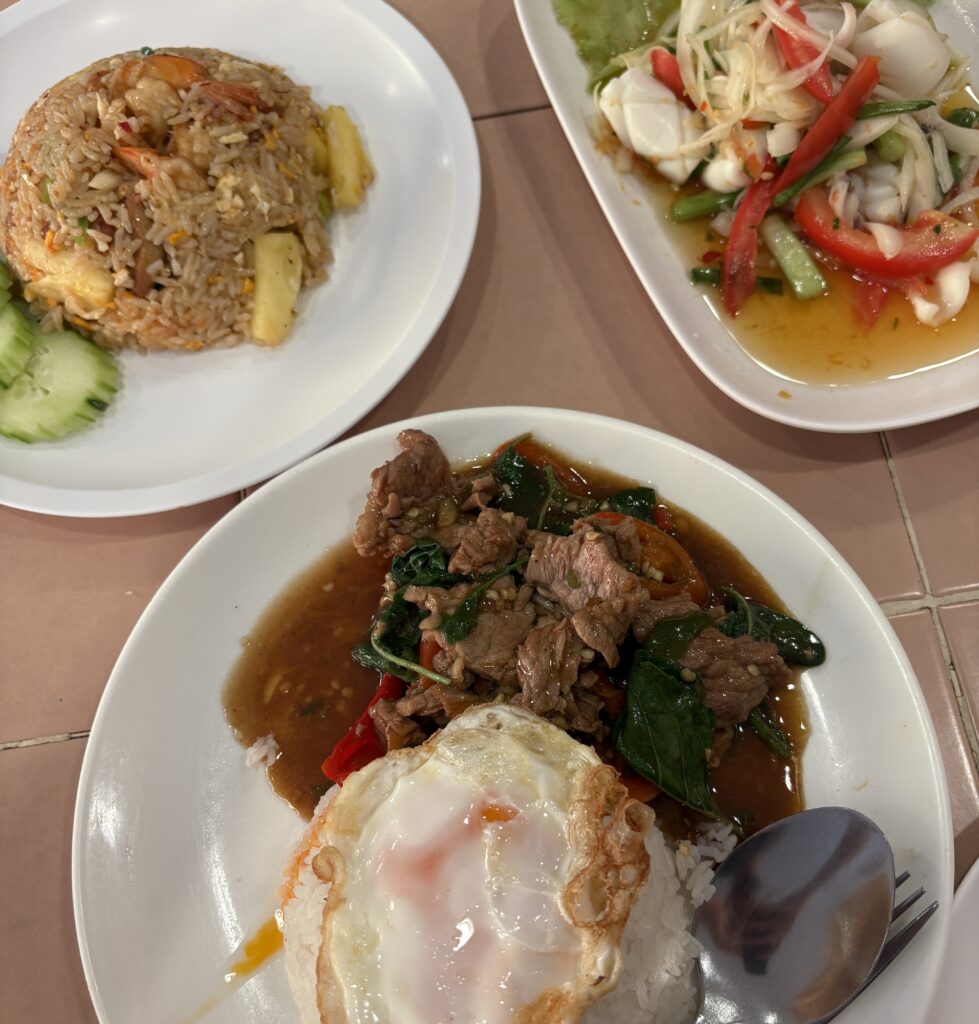
What are the must‑try Thai dishes beyond Pad Thai?
Go for Khao Soi, Som Tum, Tom Yum, Tom Kha Gai, Massaman Curry, Panang Curry, Thai Grilled Chicken, mango sticky rice, and roti. These cover Thailand’s full flavor spectrum: sweet, sour, spicy, and creamy.
Which Thai dishes are safe if I have peanut allergies?
Avoid Som Tum and satay skewers unless you ask for “no peanuts.” Most vendors will accommodate you if you inform them before placing your order.
What makes Khao Soi and Panang Curry unique?
Khao Soi is a northern coconut curry noodle soup with crispy noodles, while Panang Curry is a thicker, nutty southern curry. Both are rich, aromatic, and unforgettable.
Is it safe to eat Thai street food at night?
Yes, stick to busy vendors and food served hot. I’ve eaten across Thailand for years with only one minor stomach issue.

